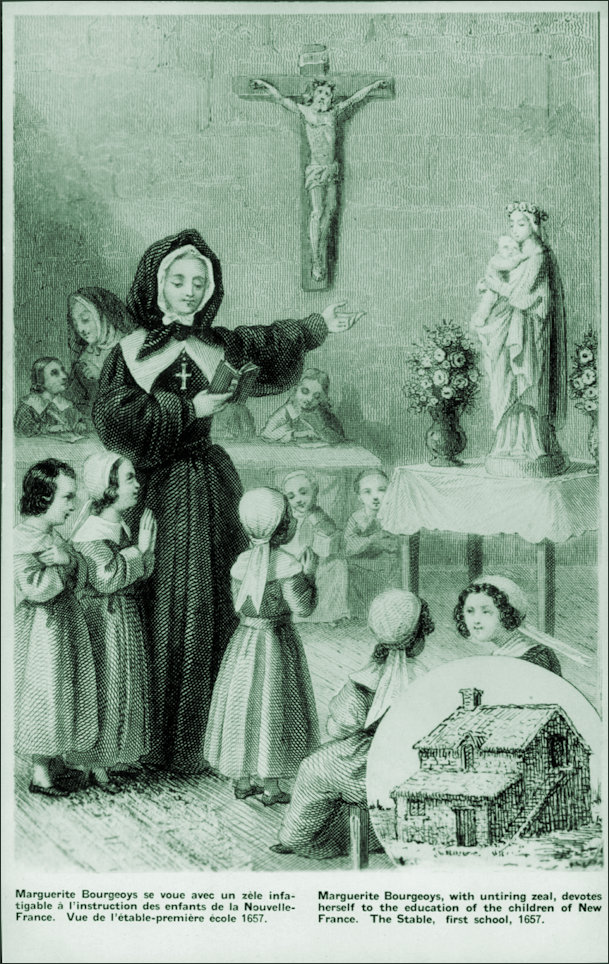Return to Book 10 / Biography of Saint Marguerite Bourgeoys
Marguerite Bourgeoys
Source: Courtesy of Bibliothèque et Archives Nationales du Québec / 52327/1954985
Rightly proud of their first woman saint the Canadians have issued postcards, ephemera and stamps in honour of Marguerite Bourgeoys - a small selection is shown below followed by additional biographical details from a variety of sites.
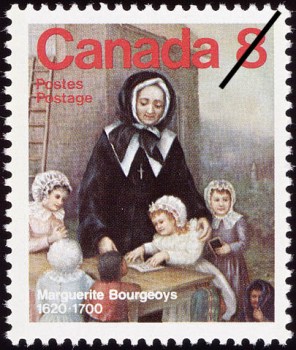
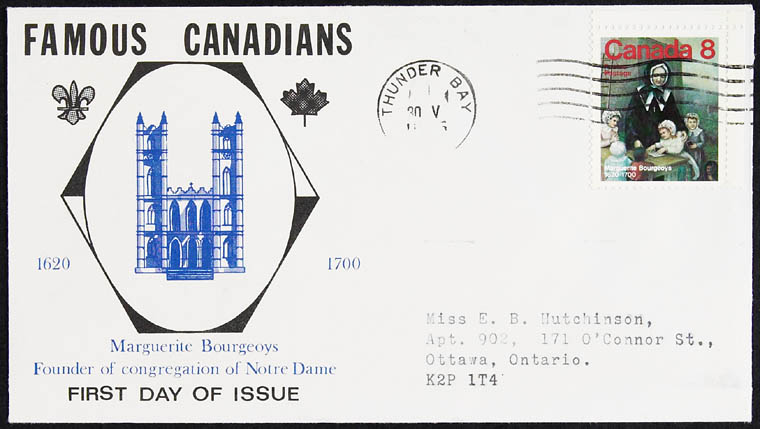
An alternative biography as found on the web-site of The Eucharistic Community of St. Luke.
St. Marguerite Bourgeoys (1620-1700)
When St. Luke's Church was consecrated by Jean-Claude Cardinal Turcotte on October 17, 2009, a relic of St. Marguerite Bourgeoys was placed in the altar. The name of the foundress of the Congregation of Notre Dame is a familiar one to most of us, but how much do we really know about her?
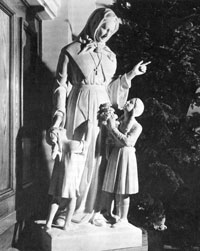 Marguerite was born in Troyes, France in 1620 to Abraham Bourgeoys, a candle merchant and his wife, Guillemette Garnier. She was the sixth of twelve children. She grew up in a happy home and although schooling at the time was limited, she probably learned to read and write and acquired the basics of arithmetic. Absorbing the teachings of her faith, she discovered the need for a strong spiritual life.
Marguerite was born in Troyes, France in 1620 to Abraham Bourgeoys, a candle merchant and his wife, Guillemette Garnier. She was the sixth of twelve children. She grew up in a happy home and although schooling at the time was limited, she probably learned to read and write and acquired the basics of arithmetic. Absorbing the teachings of her faith, she discovered the need for a strong spiritual life.
A light-hearted, happy natured young person, Marguerite loved rich fabrics, pretty clothes and ornamental touches. She was completely feminine and very human!
Her mother died when she was 19 years old, and she took over the running of her father's household and the care of her younger siblings. Intuitively, though, she knew that her ultimate calling would take her beyond the family circle.
At 20, Marguerite took part in a procession to honour Mary. It was the Feast of the Holy Rosary, and as she beheld a statue of the Blessed Virgin at the gates of the old Abbey of Notre Dame-Aux-Nonnains, she was deeply touched by "Our Lady's Smile." This was a moment of spiritual conversion and a turning point in her life. It was the start of a deep and lasting devotion to Our Lady. She was particularly inspired by Mary's Visitation to her cousin, Elizabeth and she decided that she, too, would carry Jesus to others.
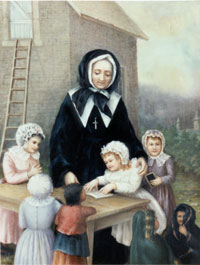
Following her "conversion" Marguerite began to dress simply and to look for ways to serve others. She joined an association for young girls which was run by the Congregation de Notre Dame and began to teach young children. She had definite leadership qualities; was popular with the other girls; and was soon elected president of the little group.
Eager to make a deeper commitment, Marguerite asked to be admitted to two religious communities, but both felt that God had other plans for her. She continued to teach; nursed her father through his final illness; and worked among the people when an epidemic of the plague hit Troyes.
In 1652, Paul Chomedey de Maisonneuve, the first Governor of Ville Marie (Mary's City) in the small colony known as New France, sailed home to report on the colony's progress over the 10 years since he had established it. He had arrived on the shore of the Saint Lawrence River with some 60 persons, including Jeanne Mance, whose mission was to open a hospital. There was now a fort along the waterfront; some primitive houses had been built; and Jeanne had opened her hospital, the Hotel Dieu.
Marguerite-Bourgeoys Museum.
The settlers were battling hunger, disease, rugged Canadian winters and the constant threat of attacks by the native Iroquois. More help was needed! As he rounded up volunteer settlers, de Maisonneuve knew that eventually, someone would be needed to open a school. Little did Marguerite dream that she was destined be that person! De Maisonneuve went to visit his sister, a member of the Congregation de Notre Dame, a teaching community in Troyes, and discussed the New World situation with her. After careful consideration, she suggested Marguerite Bourgeoys, a devout Catholic from a good family who was strong, healthy and a person of courage and perseverance. Already dedicated to the service of others, she was intelligent, knowledgeable and certainly qualified to oversee the education of Ville Marie's future children.
De Maisonneuve's request was an unexpected challenge to Marguerite. Was God calling her to leave all that was familiar and sail into the unknown? Her family was aghast at the thought! The Carmelites offered to admit her to any convent she chose. After much thought, prayer and reflection, she was convinced that Our Lady was saying to her, "Go. I will not forsake you."
Carrying a small bundle of all that she had kept of her worldly belongings under her arm, Marguerite boarded the St. Nicholas, a crude, comfortless vessel, for the eight-week voyage to Ville Marie. During that time, Marguerite would nurse men struck down by the plague, tend the dying, shroud the dead, and pray with and for the colonists. One hundred survivors arrived in the small, desolate city of Ville Marie on November 16, 1653, where they received a warm and joyous welcome and settled in to a new life.
There were, as yet, no children to teach. Marguerite became housekeeper to the Governor and helped Jeanne Mance to tend the sick. She attended to myriad mundane tasks each day. But prayer was central to her daily life and her spirituality was soon reflected in the hearts of the colonists, for she lived her message. It has been written that, "The works of mercy were her food; compassion was her song."
Marguerite asked to be taken to see the cross that had been erected on Mount Royal in 1643 in thanksgiving for receding flood waters that had threatened to destroy the settlement. She discovered that it had been demolished by the Iroquois, but undaunted, she had a new cross placed on the original site. A cross still stands on that very spot! Another of Marguerite's special projects was the construction of Notre Dame de Bonsecours Chapel, which was begun in 1657 and finally completed in 1678 after many delays. The chapel still stands on the waterfront in Old Montreal and welcomes thousands of pilgrims each year.(For more info and for a 360° virtual tour, check out the Marguerite-Bourgeoys Museum Notre-Dame-de-Bon-Secours Chapel website.)
Ville Marie's first school opened in an abandoned stable in 1658. Marguerite loved it because it reminded her of the long ago stable in Bethlehem that was Jesus' birthplace. It was here that both native and settlers' children were taught to read, write and work with numbers, as well as prepared for the sacraments. Little girls were taught the basics of homemaking. 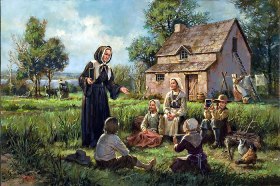
In 1659 and 1670, she travelled back to France to find young women to help her. She and her companions adopted the style of dress of their French counterparts, lived on "bread and pottage," and worked for what they needed. When food ran out, someone inevitably appeared at their door with bread and the makings of a meal. The Sisters, as they called themselves, embraced Marguerite's simple spirituality: Love God, love your neighbour, look to Mary as the perfect model of your love.As the colony grew, so did their teaching mission. They acquired a farm in Point St. Charles, and the land was worked to provide food for the Sisters and their pupils. There, they opened an industrial school which they named La Providence and taught girls trades, farming and household arts. This building, La Maison Saint Gabriel is now a museum which is fascinating to visit. Part of the building dates back to 1668.
First school established in Montreal by Marguerite Bourgeoys in 1658 © Charles Vinh, 2008.
The Sisters were actively involved in the Sulpicians' "Mountain Mission," where they taught little girls from Iroquois families. As needs arose, they opened other little schools.
Marguerite became known as the Mother of the Colony through her involvement with the colonists and the "Filles du Roi" (the King's Wards) - young women who were sent to Ville Marie to become wives of the settlers. It was she who welcomed them, sheltered them and prepared them for marriage. She attended many weddings and was often asked to be godmother to their children. Many a newborn child was named "Marguerite."
In 1670, King Louis XIV granted civil status to the Congregation de Notre Dame and in 1675, it was recognized as a secular teaching community of the Church. In 1698, their proposed Rule received the Church's stamp of approval and on June 25 of that year, Marguerite and 23 Sisters of Ville Marie pronounced vows binding then to poverty, chastity, obedience and the education of young girls.
Mother Marguerite remained Superior of the Congregation until 1693, when she was replaced by Sister Marie Barbier, the first Montrealer to join the congregation. For the next four years, she nursed the last of her original companions. At age 77, she began writing her Memoirs. She died on January 12, 1700.
Marguerite Bourgeoys was a woman of faith, hope, strength, determination and perseverance. She was a missionary who taught the Word - and lived it. Hers was a life of service to others. .. an example to the people of her time and to all of us today. On October 31, 1982, she as canonized by Pope John Paul II - the first Canadian woman to be so honoured.
A bone fragment of Saint Marguerite now reposes in the altar of St. Luke's Church. May it be an inspiration to all of us!
This story of Saint Marguerite's life is a shortened version of an article that appeared in Our Family in October 1982.
More biographical details from the History and Women website.
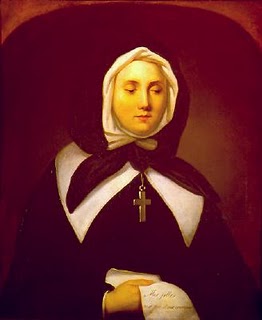 Marguerite was born in Troyes, in the province of Champagne (France), on Good Friday, April 17, 1620. Her parents, Abraham Bourgeoys and Guillemette Gamier, baptized her on the same day in the church of Saint-Jean located near her home. She was the sixth child in a family of twelve. The family was neither rich, nor poor, so she lived a rather comfortable Christian life. When Marguerite was nineteen years of age, her mother died and had to help take care of her siblings. Her father, a candle maker died when she was twenty-seven.
Marguerite was born in Troyes, in the province of Champagne (France), on Good Friday, April 17, 1620. Her parents, Abraham Bourgeoys and Guillemette Gamier, baptized her on the same day in the church of Saint-Jean located near her home. She was the sixth child in a family of twelve. The family was neither rich, nor poor, so she lived a rather comfortable Christian life. When Marguerite was nineteen years of age, her mother died and had to help take care of her siblings. Her father, a candle maker died when she was twenty-seven.
On October 7, 1640, while participating in a procession to honour Our Lady of the Rosary, she had an unforgettable experience. Her eyes rested on a statue of the Blessed Virgin, and at that moment she felt inspired to withdraw from the world and to consecrate herself to the service of God. She believed it to be God's will. With great eagerness, she set out to accept this vocation.
Almost immediately, she joined the Congregation of Troyes, a convent of young girls devoted to teaching children in the poor districts of the town. In 1642, while engaged in this work, she learned about the foundation of Ville Marie (Montreal) in Canada, but it wasn't until 1652 when she met Monsieur de Maisonneuve, founder and governor of the settlement of New France, that she volunteered her services. She longed to teach French and Indian children. Marguerite gave away her share of her inheritance from her parents to other members of her family and departed from Troyes in February, 1653 and arrived in Montreal on the following 16th of November. She began working immediately.
Marguerite Bourgeoys (April 17, 1620 - January 12, 1700)
When she arrived in Ville Marie, as it was called then, she found that few children survived to school age. She helped the remarkable Jeanne Mance, who ran the hospital, to change this tragedy. One of the first things she did was restore the Cross on Mount Royal after it was destroyed by hostile Indians. She also undertook the construction of a chapel dedicated to Notre-Dame de Bon Secours. In 1658, in a stable which had been given to her by the governor for her use, she opened the first school in Montreal. She also organized a convent patterned after the one which she had lived in while in Troyes.
But her Sisters were more than willing to live in huts in order to fulfil their call from God. She had set up schools all over the territory, not just for children. When the king, in well-meaning ignorance, had sent untrained orphans over to be colonists she had set up a school for the women to teach them how to survive and thrive in Canada.
In 1659, she began receiving girls who were recommended by "les cures" in France, or endowed by the King, to come to establish homes in Montreal, and she became a real mother to them. This initiated a school system and a network of social services which led people to refer to her as "Mother of the Colony".
Marguerite Bourgeoys returned to France three times to recruit more teachers. This new group of nuns wanted to remain uncloistered, free to conduct their work. The concept was an innovation at that time. They called themselves the Congregation de Notre-Dame and they received approval from Louis XIV in 1671 and the Bishop of Quebec in 1676.
The sisters helped people in the colony survive when food was scarce, opened a vocational school, taught young people how to run a home and farm. Marguerite's congregation grew to 18 sisters, seven of them Canadian. They opened missions, and two sisters taught at the Native American school. Soon after, Marguerite received the first two Native American women into the congregation.
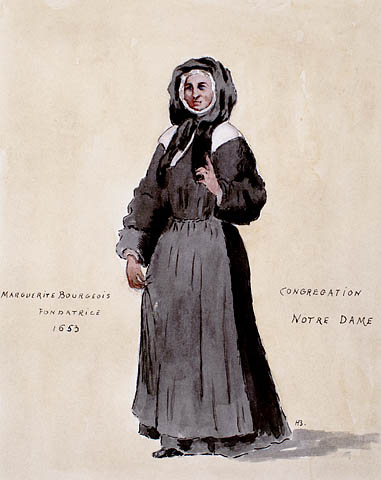
Marguerite had survived many threats in the twenty-six years she had been in wilderness of Canada. She had lived through Iroquois attacks, a fire that destroyed her small village, plagues on the ships that she took back and forth to France, but nothing threatened her dreams and hopes more than what her own bishop said to her in 1679. He told her that she had to join her Congregation of Notre Dame with its teaching sisters to a cloistered religious order of Ursulines. This was not the first time she'd heard this command. Whether from a misplaced desire to protect her Sisters or from discomfort in dealing with an active religious order of women, bishops had long wanted to fit her into the usual mold of cloistered orders.
So she was not ready to surrender to the bishop. There was too much at stake. She reminded him that the Ursulines because they were cloistered could not go out and teach, as her Sisters had done. The poor and uneducated would not and could not travel to a Quebec cloister over miles of frontier at the risk of their lives. In this way, she managed to hold her ground and retain independence for her order.
![]() In 1693, with her foundation assured, Marguerite handed over her congregation to her successor, Marie Barbier, the first Canadian to join the order. She wrote her autobiography.
In 1693, with her foundation assured, Marguerite handed over her congregation to her successor, Marie Barbier, the first Canadian to join the order. She wrote her autobiography.
On December 31, 1699, a young sister lay dying and Mother Marguerite asked God to take her life in exchange. The next morning of January 1, 1700, the sister was completely well, but Mother Marguerite had a raging fever. She suffered for twelve days and then on January 12, 1700 in Montreal.
She is buried in the sanctuary of Notre-Dame-de-Bon-Secours Chapel in Montreal, which also houses a museum about her life and the early history of Montreal. She is acknowledged for her holiness of life. Today, her commitment lives on through the members of the community she founded. More than 2,600 Sisters of the Congregation de Notre-Dame now work in the fields of education and the promotion of family in Canada, the United States, Japan, Latin America, Cameroon, and most recently in France.
On November 12, 1950 Pope Pius XII beatified Marguerite Bourgeoys. Canonizing her this October 31, 1982, Pope John Paul II gives the Canadian Church its first woman saint.
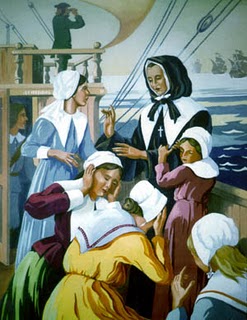
From the Catholic Fire web-site : In the course of her adult life, she sailed across the ocean three times to France to obtain additional volunteer teachers. The group of teachers who joined her in her life of prayer, of poverty, and of service to others, bonded together as a religious group. Thus, in 1698, Marguerite founded the Congregation of Notre Dame – an active Order who would continue the missionary work she started.
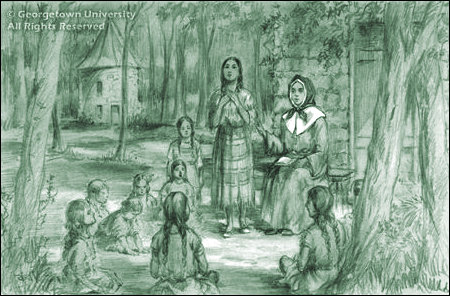
Marguerite Bourgeoys (1620 - 1700) was one of the early religious leaders of the mission at Ville-Marie(now Montréal). The drawing also depicts Kateri Tekakwitha (1656 - 1680), an Iroquois orphan who took her vows near Montréal in 1679.
Return to Top / Angélique Home Page / Home Page
Page refreshed : 6th February 2017

